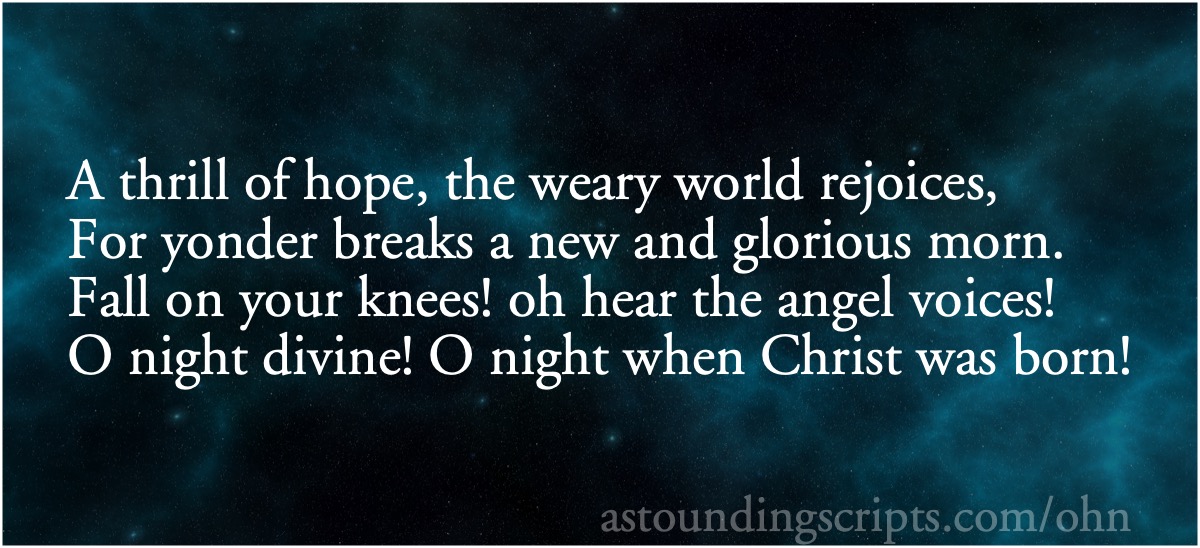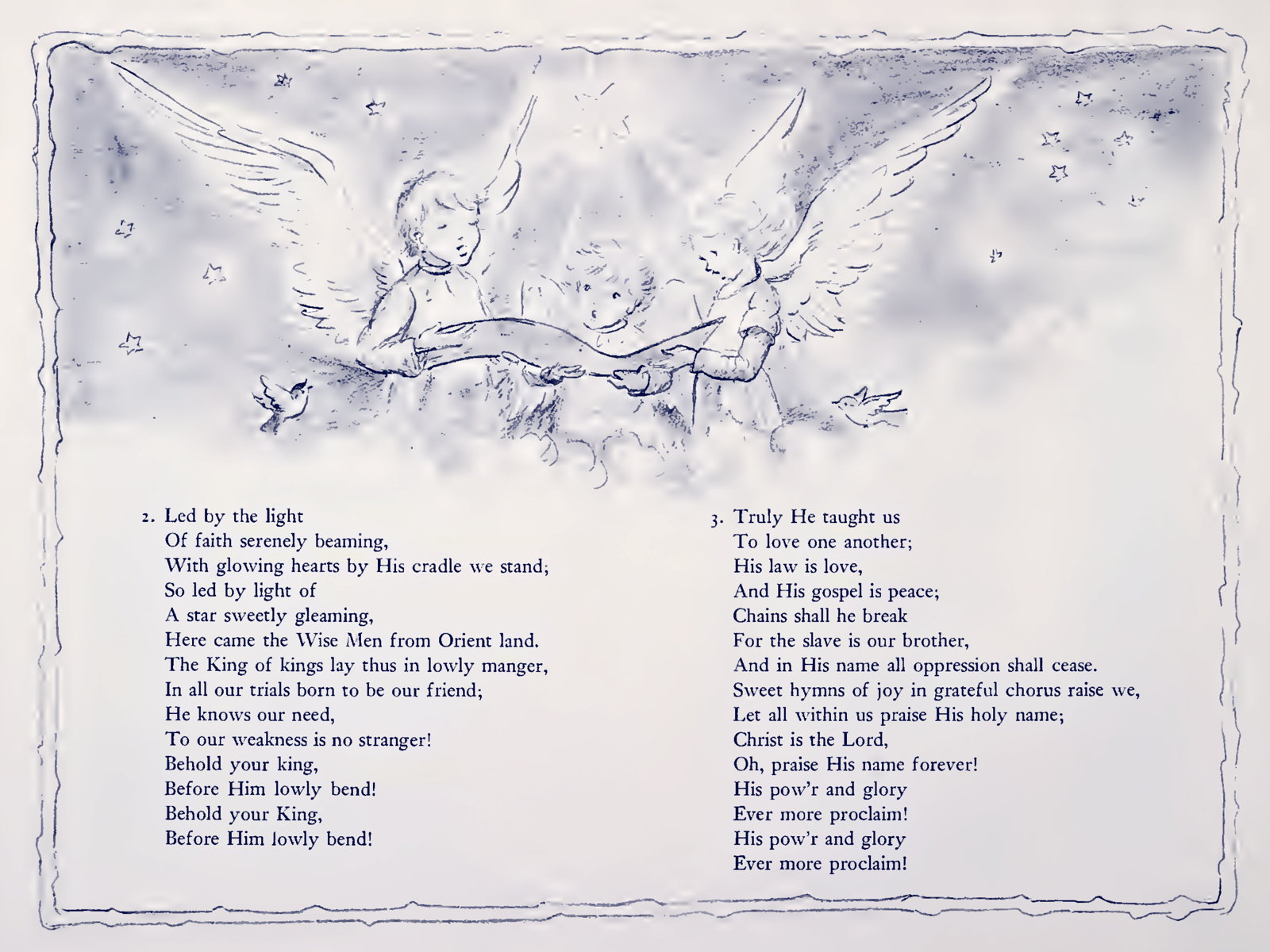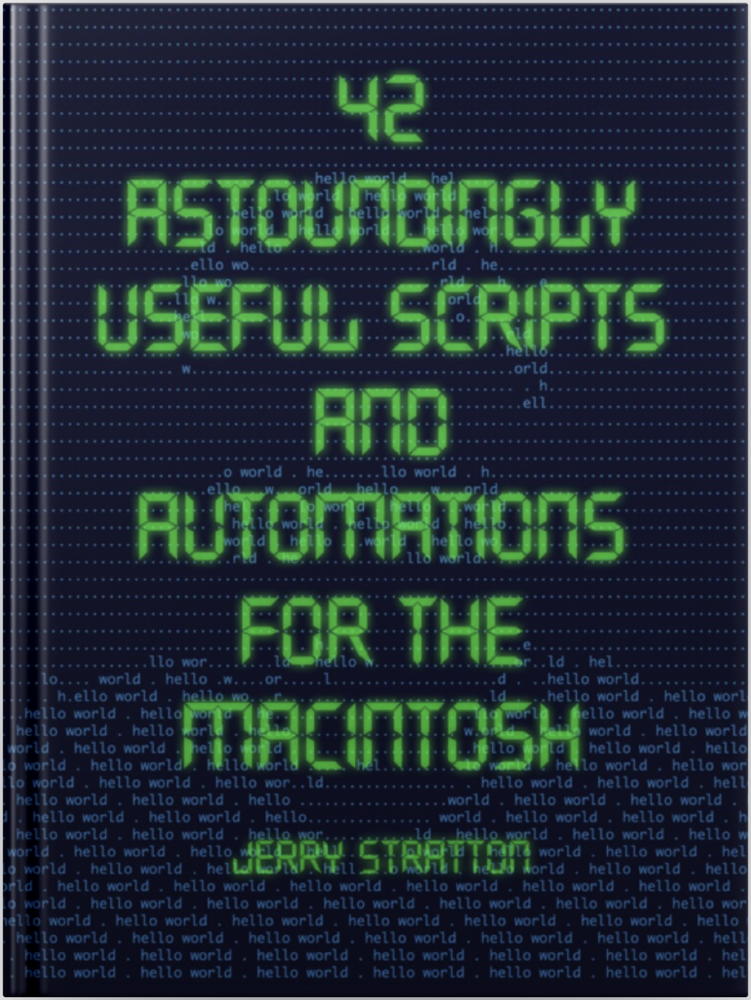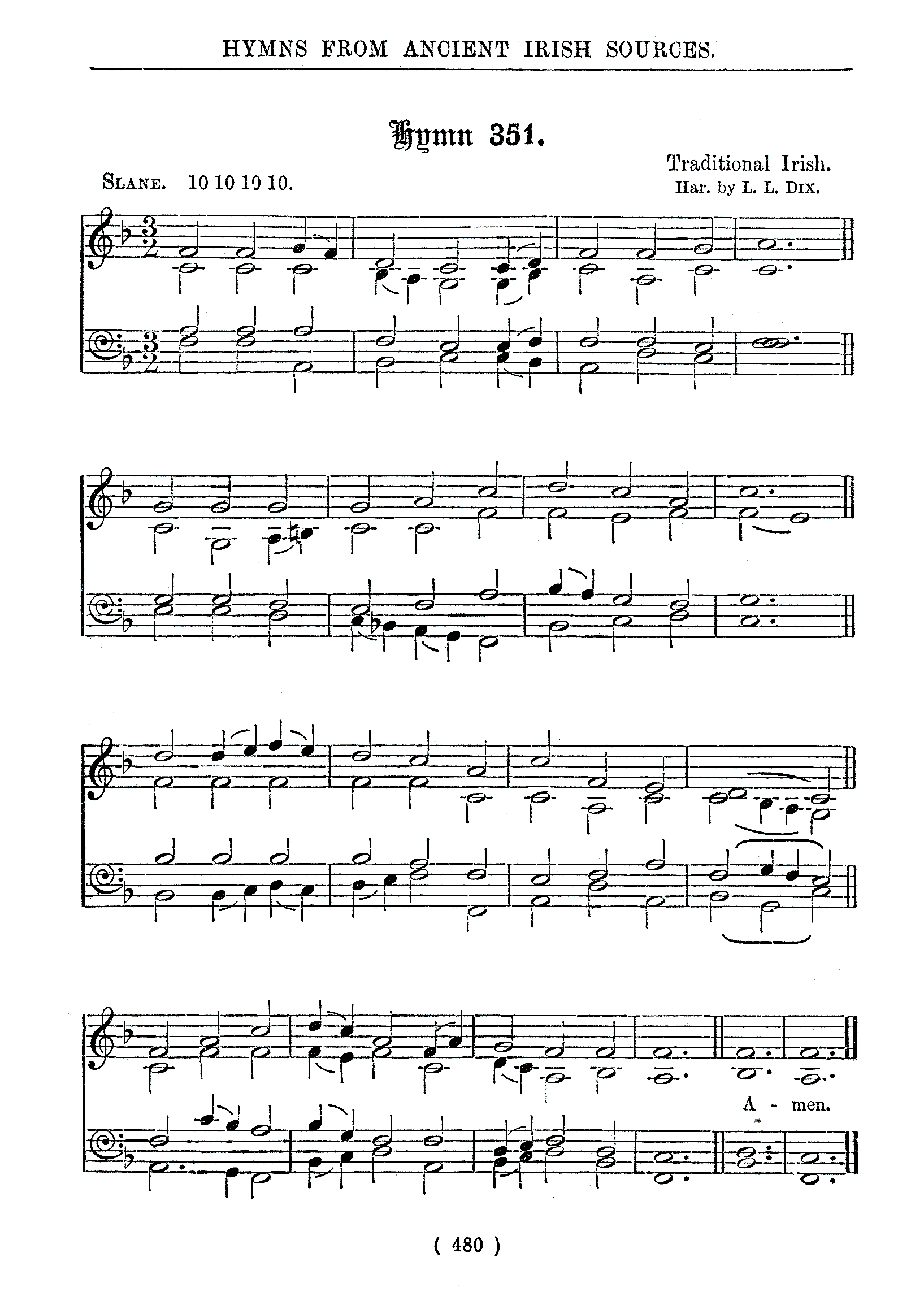
Earlier this year I discovered the Brian Setzer Orchestra’s Boogie Woogie Christmas at a garage sale in Michigan. Their version of O Holy Night reminded me just how wonderful and inspiring a song O Holy Night is. And after a difficult year, how much it expresses the yearning and emptiness that celebrating Christmas both secularly and religiously can fill.
- Long lay the world in sin and error pining,
- Till He appeared and the soul felt its worth.
“A thrill of hope, the weary world rejoices…” Some Christmases we need the opportunity for rejoicing more than others.
There are three verses, but in my experience, “O Holy Night” is almost always sung with only the first verse. Partly I suspect that’s because the second and third verses don’t scan very well, and in addition the third verse’s mention of slavery is viewed as somewhat outdated. The line wasn’t initially directed at American slavery: the original lyrics were French. They were written in after the French revolution, in 1843; my guess is that the slaves in the lyrics almost certainly referred to French citizens, no longer slaves of the King and other royalty.
The lyrics were translated into English by Bostonian John Sullivan Dwight in 1855. Dwight’s translation is very loose, but the original third verse’s “Il voit un frère où n’était qu’un esclave…” tracks very closely with Dwight’s “for the slave is our brother”.
I can find no evidence that Dwight was an ardent or even occasional abolitionist. He was a music critic and magazine publisher. He did, apparently, include “the music of black Americans” in his magazine when submitted. The 1855 volumes of his magazine, if the Internet Archive’s OCR is to be trusted, contain no mention of “abolition” other than one about “the abolition of the mock auction system” in the selling of concert tickets and another about the “total abolition of hymn books”. The only mention of “negro” is in reference to music.
Regardless, his translation takes a direct approach appropriate for pre-Civil War America. Whether it was made for the cause or not, that third verse was taken up by abolitionists and so is associated with the effort to free slaves in the United States. But that association also made the lyrics less obviously relevant post-Civil War once Lincoln and his radical Republicans abolished slavery in the United States.
Dwight also doesn’t appear to have printed his translation in his own magazine, unless it was printed well outside of the 1855 volumes, or, again, the Archive’s OCR failed me.1
Here are the English lyrics from the 1900 Catholic School and Sodality Hymnal2:
- O holy night! the stars are brightly shining,
- It is the night of the dear Saviour’s birth;
- Long lay the world in sin and error pining,
- Till He appeared and the soul felt its worth.
- A thrill of hope, the weary world rejoices,
- For yonder breaks a new and glorious morn.
- Fall on your knees! oh hear the angel voices!
- O night divine! O night when Christ was born!
- O night divine! O night, O night divine!
- CHORUS
- Fall on your knees! oh hear the angel voices,
- O night divine! O night when Christ was born!
- O night divine! O night, O night divine!
- Led by the light of Faith serenely beaming,
- With glowing hearts by His cradle we stand;
- So led by light of a star sweetly gleaming,
- Here came the wise men from the Orient Land.
- The King of Kings lay thus in lowly manger.
- In all our trials born to be our friend;
- He knows our need, to our weakness no stranger,
- Behold your King! before Him lowly bend;
- Behold your King, your King, before Him bend.
- CHORUS
- Truly He taught us to love one another,
- His law is Love, and His gospel is Peace;
- Chains shall He break, for the slave is our brother,
- And in His name all oppression shall cease.
- Sweet hymns of joy in grateful chorus raise we;
- Let all within us praise His holy name;
- Christ is our Lord! oh, then ever praise we
- His pow’r and glory ever more proclaim.
- His glory, His glory, evermore proclaim.
- CHORUS

A wonderful illustration from Tasha Tudor for her Take Joy! Christmas book.
The first verse is definitely the most thrilling. When the melody rises on “when the soul felt its worth”, it lifts the soul. The second and third verses, with the same melody, seem like barely-edited afterthoughts. I know that American English was very different a hundred and seventy years ago, but unless stresses and pauses were also very different in 1855—which they well could have been—the word order is, in my opinion, twisted around too much to fit the melody, resulting in very awkward singing.
This isn’t surprising. As it happens, I recently read Mark Steyn’s amazing Broadway Babies Say Goodnight•, a history of the Broadway/London musical. The best music, at least in musicals, is written in order of: the story, then the music, then the lyrics. It is much easier to fit lyrics to music than it is to fit music to lyrics that were written without the music in mind. That’s part of why translations of song lyrics tend to be very loose. They have to be. O Holy Night could probably have benefited from an even looser translation.
O Holy Night was a poem before it was a song. Placide Cappeau wrote it in 1843 in Roquemaure, France, and very quickly recognized as worth singing. Different accounts say different things about whether the poem was originally meant to be set to music or if it was set to music later, but all say that the lyrics came before the music.
Whatever the troubles with the second and third verses, the first verse makes it all worth it. Placide Cappeau’s text and Adolphe Adam’s music combine to one of the best Christmas songs even centuries after it was written.
When typing this up for the piano script from 42 Astounding Scripts I used the 1916 Carols Old and Carols New, which contains a very impressive arrangement by the Reverend Charles L. Hutchins of Boston for, if I’m reading it right, the Boston parish choir. I cut out the singing-in-canon part of the chorus, since it doesn’t make much sense without vocals. If you’re looking for a nice arrangement for your choir’s Christmas service, however, you might take a look at it—at this point, probably for next year! My guess is that it would require serious rehearsing.
The sheet music I used, a wonderful arrangement by Reverend Charles L. Hutchins in Carols Old and Carols New.
When combining the three staves—the treble staff for the lyrics, and the treble and bass staves in the rhythm and bass line below it—in GarageBand I decided on a French Horn for the lyrics, a Grand Piano for the rhythm, and an Upright Studio Bass for the very drum-like bass line.
For the images in the slideshow, I started with some night scenes from Earth, progressed to some amazing photos of deep space from NASA, and then returned to Earth for a Chattanooga sunrise—just because I liked the photo—and a Christmas tree.
The Christmas tree is my Christmas tree as I write this. It’s sparser than normal, with only a few ornaments. We’ve had a few deaths in the family this year, including my mother. The first ornaments I put on the tree after the lights were two ornaments made by my parents’ grandchildren—my grand-nieces—for each member of the family to remember my mother by.
I liked it so much that I decided that for the ornaments I was going to go with only ornaments made by family members. Some of them were made by me as a child, and some were made by relatives who enjoy crafting far more than I do.
In keeping with the sparseness theme, this slideshow only contains a few photos. It’s a short slideshow, only two and a half minutes, and it remains on each photo for a much longer time than I normally design slideshows to do.
As normal for these things, I didn’t use any special software beyond my own piano script. I created the music file in GarageBand and the slideshow in Photos.
The archive (Zip file, 4.2 MB) contains the sheet music taken from Carols Old and Carols New, as well as the piano script files and MIDI files. So if you want to edit the music or make your own slideshow, you are welcome to do so! The piano script is part of 42 Astoundingly Useful Scripts and Automations for the Macintosh. GarageBand and Photos, of course, come with any new Macintosh or iPad/iPhone.
Enjoy!
I searched on “holy” and “divine”.
↑According to the built-in dictionary on macOS, a “Sodality” is a Catholic brotherhood or guild.
↑
books
- 42 Astoundingly Useful Scripts and Automations for the Macintosh
- MacOS uses Perl, Python, AppleScript, and Automator and you can write scripts in all of these. Build a talking alarm. Roll dice. Preflight your social media comments. Play music and create ASCII art. Get your retro on and bring your Macintosh into the world of tomorrow with 42 Astoundingly Useful Scripts and Automations for the Macintosh!
- Broadway Babies Say Goodnight•: Mark Steyn (paperback)
- “The glorious tradition of the Broadway musical from Irving Berlin to Jerome Kern and Rodgers and Hammerstein to Stephen Sondheim. And then… Cats and Les Miz. …a sharp-eyed view of the whole span of Broadway musical history, seven decades of brilliant achievements the best of which are among the finest works American artists have made.”
- Carols Old and Carols New: Reverend Charles L. Hutchins at Internet Archive
-
 “For use at Christmas and other seasons of the Christian year.” From 1916.
“For use at Christmas and other seasons of the Christian year.” From 1916.
- Catholic School and Sodality Hymnal at Internet Archive
- Lyrics, but not melodies, from 1900.
- St. Basil’s Hymnal at Internet Archive
- “An extensive collection of English and Latin hymns for church, school and home, arranged for feasts and seasons of the ecclesiastical year; Gregorian masses, vespers, motets for benediction, litanies, etc.” From 1918.
- Take joy! The Tasha Tudor Christmas Book: Tasha Tudor at Internet Archive
- A wonderfully-illustrated book of Christmas hymns and stories.
John Sullivan Dwight
- The Cultivated White Tradition and Black Music in Nineteenth-Century America: Thomas Riis
- “As the first major music critic to appear in the United States, and as an obvious and vocal exponent of the cultivated European traditions in this country, John Sullivan Dwight must be recognized as an especially important arbiter of musical taste in mid-nineteenth-century America.”
- Hearing Moral Reform: Abolitionists and Slave Music, 1838-1870: Karl Byrn
- “How did a fluid musical culture make it possible for Dwight to suspect, and Lucy to confirm, that something familiar—and morally worthwhile—existed in African-American music?… Dwight traveled in literary and utopian circles, and promoted a vision of symphonic music as transcendent art that would redeem society.”
O Holy Night
- Cantique de Noël or, Minuit, Chrétiens: Todd Victor Leone
- French lyrics on which O Holy Night was based, with a more strict English translation.
- O Holy Night
- The mp3 file of O Holy Night, created in GarageBand from a MIDI file created by the 42 Astounding Scripts piano script.
- O Holy Night music files (Zip file, 4.2 MB)
- The piano script text files, MIDI files, audio file, and sheet music for O Holy Night.
- O Holy Night slideshow in space at Mimsy@YouTube
- “O Holy Night”, created on the piano script from 42 Astounding Scripts, and then turned into a slideshow using GarageBand and Photos.
- O Holy Night (PDF File, 788.1 KB)
- Arrangement by Reverend Charles L. Hutchins for Carols Old and Carols New.
More Christmas music
- Light a candle for Christmas hymns
- While the holidays brought more examples of bowdlerized lyrics they also brought, at least to our church, a lit candle for the darkness, in the form of a new hymnal that retains sound Catholic theology.
- Have yourself a musical command line…
- …Make your scripting gay. From now on your errors will be miles away!
- 8 (bit) Days of Christmas: Day 1 (Do You Hear What I Hear?)
- For day 1 of the 8 (bit) days of Christmas, John Mosley’s “Do You Hear What I Hear?” from the December, 1987, Rainbow Magazine. Mosley coaxes four-voice music out of the CoCo 1 and 2 using a machine-language program.
- O Little Town of Bethlehem
- How still we see thee lie. Play this song on your Mac’s command line with the piano script.
- Tidings of Comfort and Joy
- One of my favorite Christmas songs. Save us all from Satan’s power, and tidings of comfort and joy.
- Two more pages with the topic Christmas music, and other related pages
More Hymns
- Save That Thou Art
- High King of heaven, when vict’ry is won/May I reach heaven’s joys, bright heaven’s Sun!/Heart of my heart, whatever befall,/Still be my vision, O Ruler of all.
- Light a candle for Christmas hymns
- While the holidays brought more examples of bowdlerized lyrics they also brought, at least to our church, a lit candle for the darkness, in the form of a new hymnal that retains sound Catholic theology.
- Our parental unit, who art, somewhere, maybe
- God’s Blessing Sends Us Forth; We Are the Light of the World; With a Shepherd’s Care. Is there room for God the Father in the modern church? Are the bowdlerizers creating a first-contact crisis?
- Let mortal tongues awake
- Samuel Francis Smith’s America—more commonly known as “My Country, ’Tis of Thee”— is short, direct, and a wonderful hymn to God as the soul of liberty. It’s a perfect hymn for the Fourth of July. It’s also very easy to play using the piano script from 42 Astounding Scripts.
- Though the Darkness Hide Thee
- Removing mankind from hymns makes them less inclusive and more self-centered. The new language almost always destroys the universality—the catholicity—of the older language. It also has a tendency to deny the necessity of God’s grace.
- Five more pages with the topic Hymns, and other related pages

